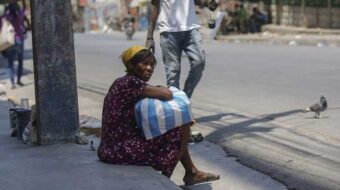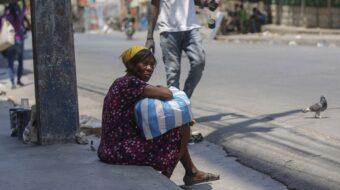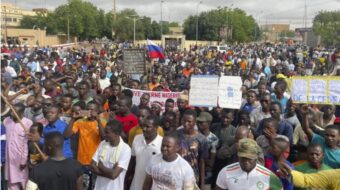The G-20 summit convening in London on April 2 is preparing to create a quarter trillion dollars of brand new stimulus money to help poor countries battle the global recession.
World leaders plan to use a little-known form of global currency to pay the freight, a currency known technically as ‘Special Drawing Rights’ (SDRs) but often referred to as ‘paper gold.’ It’s a currency that can be issued by the International Monetary Fund (IMF), and the Telegraph has reported that the U.S. government is keen on the idea.
Senior figures in the U.S. Treasury have been encouraging the Fund to issue hundreds of billions of dollars worth [of SDRs] to prevent the recession from turning into a global depression.
If leaders at the G-20 summit can create ‘paper gold’ to jump-start the global economy, they can also turn it in a green direction to jump-start protection of the global climate.
They should put much of paper gold stimulus under discussion into an international fund, to help developing countries pay for climate protection. Such an action would remove the greatest stumbling block in the way of international climate action — the lack of financing to pay for energy conservation, technology transfer, adaptation, forest conservation, clean energy, and research and development. It would allow negotiators to arrive in Copenhagen for climate talks at the end of the year with the finances in place to negotiate and sign a global deal.
Without the financing, the chances of success in Copenhagen are slim. Yves De Boer, the UN’s climate chief, left no doubt about that in comments he made this week criticizing EU finance ministers for putting conditions on financial help for developing countries, contrary to promises made in Bali in 2007:
I think without clarity on finance from industrialized countries there will be no commitment from developing countries.
‘Paper gold’ offers a way out of this stalemate — a way to mobilize resources without either taxing or borrowing. That’s why G-20 leaders are proposing to issue a quarter trillion dollars worth of new SDRs – and why paper gold can play a crucial role in protecting the climate, too.
Measures that would fight both global warming and global economic meltdown simultaneously are being called a ‘Green New Deal.’ At the climate talks in Poznan last December, UN Secretary-General Ban Ki-moon called a ‘Global Green New Deal’ the best chance for securing a climate agreement in Copenhagen in late 2009. And in a February op-ed in the Financial Times, Ban together with Al Gore wrote,
What we need is both stimulus and long-term investments that accomplish two objectives simultaneously with one global economic policy response — a policy that addresses our urgent and immediate economic and social needs and that launches a new green global economy.
World leaders convening at the G-20 have the opportunity to do just that.
The SDR Backstory
Countries normally set aside reserves, most often in gold and U.S. Treasury bills, as insurance to protect their currencies against speculation, runs, and other forms of economic adversity. If a country’s currency starts to plummet in value, the government can use the reserves to buy back its own currency and stabilize it.
The mountains of U.S. Treasury bills hoarded by China and Japan, for example, were purchased in order to protect their currencies against the kind of runs that devastated national currencies during the so-called Asian financial crisis of the late 1990s. Global currency reserves amount to trillions of dollars, and they currently sit idle in national treasuries.
In 1969, after a string of liquidity crises, the world’s major governments agreed to create SDRs to increase global liquidity. Nobel laureate and former World Bank chief economist Joseph Stiglitz explains that SDRs as ‘a kind of global money … which countries agree to accept and exchange for dollars or other hard currencies.’ If countries are provided SDRs to add to the gold and foreign currency in their national reserves, money can be put to use for other purposes instead of sitting idle — for things like combating global warming.
Several years ago, Stiglitz proposed that SDRs or a new ‘global greenback’ along similar lines be used to supplement other reserve currencies. They would be issued for investment in developing countries and for ‘global public goods’ like environmental projects, health initiatives, and humanitarian assistance. They would have the added benefit of checking global deflation and would help countries with trade deficits avoid ruinous devaluations and runs on their currencies.
Until the current economic crisis, such ideas received little public attention — indeed, few except international economists even knew SDRs existed. But since the beginning of 2009, discussion of paper gold has exploded. George Soros has called for ‘trillions of dollars’ in SDRs to be issued. And now British Prime Minister Gordon Brown has campaigned for countries to agree to a new allocation of SDRs at the G-20 meeting that starts on April 2, and the U.S. seems to be warming to the idea.
These world leaders are well aware of the threat of global warming and the cost of fighting it — roughly half a trillion dollars a year, according to the British government’s Stern Review on the Economics of Climate Change. That amounts to about 1 percent of global GDP for the next three to four decades. So far, however, none of these leaders has publicly discussed using paper gold to help pay for climate protection.
Green Paper Gold Can Finance Climate Protection
In the same way that economic stimulus measures around the world have pumped new funds into the green measures, global leaders can deploy ‘paper gold’ to finance climate protection. It would surely qualify as a ‘global public good,’ as Stiglitz put it, and at the same time provide a needed economic stimulus.
The creation of paper gold is the international equivalent of increasing a nation’s money supply. It is what economists call ‘quantitative easing,’ and paper gold does it on an international scale. Former IMF chief economist Simon Johnson explains the current G-20 proposal:
The principle behind it is that everyone would get bonus dollars. The objective is to create a windfall of cash.
As in a stimulus measure applied to a national economy (for example, America’s Recovery and Reinvestment Act of 2009), if the windfall of cash is used to generate economic activity, then the value created by the new activity is what pays for the initial spending over time. The global recession has put millions of people and productive resources out of service. If they could be mobilized effectively, these vast unused productive capacities might well be sufficient by themselves to rebuild the global economy on a low-carbon basis before it is too late.
Some experts warn that paper gold will cause inflation, but we are in the midst of a historic crisis of deflation, in which the IMF, the U.S., and the great majority of economists are calling for economic stimulus to counter deflation. Issuing paper gold is precisely such an economic stimulus, providing at the global level what national stimulus plans provide at the level of an individual country.
The IMF is calling for a global stimulus of 2 percent of the world’s total product to sustain global demand in the current economic downturn — about $1.2 trillion. Less than half of that would cover the projected annual cost of protecting the world’s climate and also provide a stimulus at the same time.
Further, if paper gold is used to stimulate work and production through green public works using material and human resources that would otherwise lie idle, they will create new value at least a great as their own value, forestalling any inflationary effect. Even if there were an inflationary effect, it would affect all countries approximately equally, so that one of the main downsides of inflation – exchange rate volatility — would not occur.
It is easy to agree in theory that all countries should coordinate their economies to provide their fair share of the needed global economic stimulus, but in practice, they often pursue their own national interests — or those of their most politically powerful constituencies. That’s why national stimulus spending carries a risk. The stimulus will create new spending at home — but it may primarily benefit the economies of other nations that supply cheap exports and do not stimulate their own economies — something called a ‘free rider’ problem. Paper gold, however, overcomes this because it stimulates the global economy as a whole, and therefore benefits the global economy as a whole.
As Tom Vosa, head of economic research at nabCapital in London explains, ‘If one or two countries do fiscal packages, that’s simply going to boost the export market for countries which haven’t.’ There’s widespread agreement among the world’s biggest countries that the current global financial and economic crises require global solutions, and that’s why paper gold is being looked at as a powerful new tool for concerted international action.
How It Can Work
There is one serious problem with using SDRs for climate protection: many believe the IMF has a poor record of environmental stewardship and concern for the poor, and environmental and social justice advocates cringe at the notion of expanding the IMF’s reach into climate territory.
There are two possible solutions. Countries can agree to create an entirely new form of paper gold, such as the ‘global greenback’ proposed by Stiglitz, that does not involve the IMF, but such a reinvention of the wheel is likely to be slow, contentious and impractical. That is why in our current economic and climate emergency, an alternative built on existing mechanisms is necessary, one that would require the IMF to issue SDRs to a global climate protection trust fund overseen by another institution — such as the United Nations Environmental Program (UNEP).
The UNEP’s authoritative scientific committee, the Intergovernmental Panel on Climate Change (IPCC), could play a major role in setting criteria and evaluating the results. Countries would apply to the trust fund for green paper gold and be allowed to use it solely to implement their national plans to reduce greenhouse gas emissions and honor international climate commitments.
Complete transparency in allocating and contracting would be an ironclad condition for receiving green paper gold. The funds would be allocated based on countries’ need in paying for their own climate protection costs and the importance of their efforts to global climate protection targets. The funds could also be allocated, as Stiglitz has suggested, by competition among countries for the most worthwhile projects.
International climate protection efforts have been stymied by conflict between developed and developing countries over who should bear the cost of mitigation and adaptation, but green paper gold can provide the basis for a ‘grand bargain’ in which climate protection would be an environmental and economic win-win, with poor countries least able to pay at the front of the queue.
If the Copenhagen climate negotiations are to succeed, they must find a way to finance climate protection efforts. If world leaders are serious about protecting the global economy and global climate, they should commit to a green paper gold bargain at the April 2 conference in London and consummate the deal at Copenhagen.
[Originally published at SolveClimate.com]











Comments